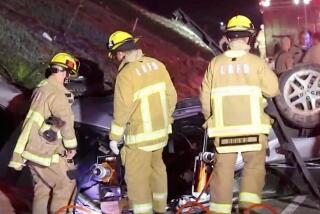Locomotive Demolishes Auto : Staged Train-Car Crash Makes a Safety Point
On a railroad crossing north of Miramar Naval Air Station Tuesday morning, the Santa Fe Southern Pacific Corporation orchestrated an elaborate fantasy of death.
Carefully, railroad employees placed a tan, four-door sedan across the tracks, its nose poking over the rails like a dog peeking over a fence. Then, they fired up the diesel engines, accelerated the 450 tons of locomotive to 30 miles an hour, leaned on the air horn and plowed into the car with a force that felt like a depth charge going off.
Three hundred feet later, the screeching stopped. A coupling on the front of the train had punctured the driverâs side of the car, which was folded like a fortune cookie.
âWhat weâre trying to emphasize here is the train will always win,â said Homer C. Henry, a Santa Fe foreman of locomotives, who was at the throttle when the three-locomotive train plunged into the car.
The point was well taken. Dozens of police officers, reporters, photographers, railroad employees, firefighters and other on-lookers were so transfixed by the death fantasy that they raced over to the crunched car and picked over it, as if they were looking for a trace of loved ones.
Spectators included San Diego police and members of a special California Highway Patrol team that is based in Los Angeles and investigates car accidents resulting in multiple deaths.
The convincing demonstration was sponsored by the railroad to show what is likely to happen when people play âchickenâ at railroad crossings. The last time the company staged the death fantasy was in 1980. Officials decided to do it again because preliminary reports indicate that train-car accident rose last year.
In 1983, the last year for which comprehensive statistics are available, 24 people died in collisions with trains in California. Some of those deaths are suicides, where people purposefully walk in front of the trains, Henry said.
But others occur when motorists, apparently oblivious to the tons of steel bearing down on them, either drive past red warning lights or around safety arms that stretch across the road to prevent entrance into crossings.
Amazingly, Henry said, 40% of the accidents happen when the motorists run into the side of a train that is already in the crossing. About 50% of the accidents occur during daylight hours, most of them between 4:30 p.m. and 7 p.m. as people race home from work, Henry said.
âGetting to work, they can be stalled for two minutes,â he explained about people willing to wait for trains in the mornings. âBut going home, itâs death to anybody in my way.
âYou wonder whatâs on peoplesâ minds. Theyâre playing Russian roulette. If you win, you save two or three minutes. If you lose, you possibly lose your life.â
Henry said it is not easy to stop a speeding locomotive. The average freight train, which pulls 6,000 tons and cruises through crossings at 60 miles an hour, takes 8,500 feet to stop, compared to 287 feet for a car with good brakes.
More to Read
Sign up for Essential California
The most important California stories and recommendations in your inbox every morning.
You may occasionally receive promotional content from the Los Angeles Times.










